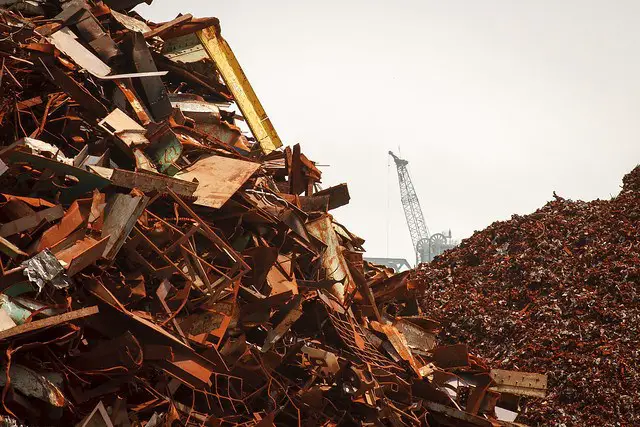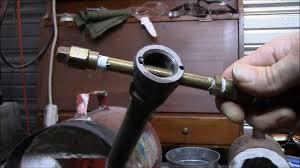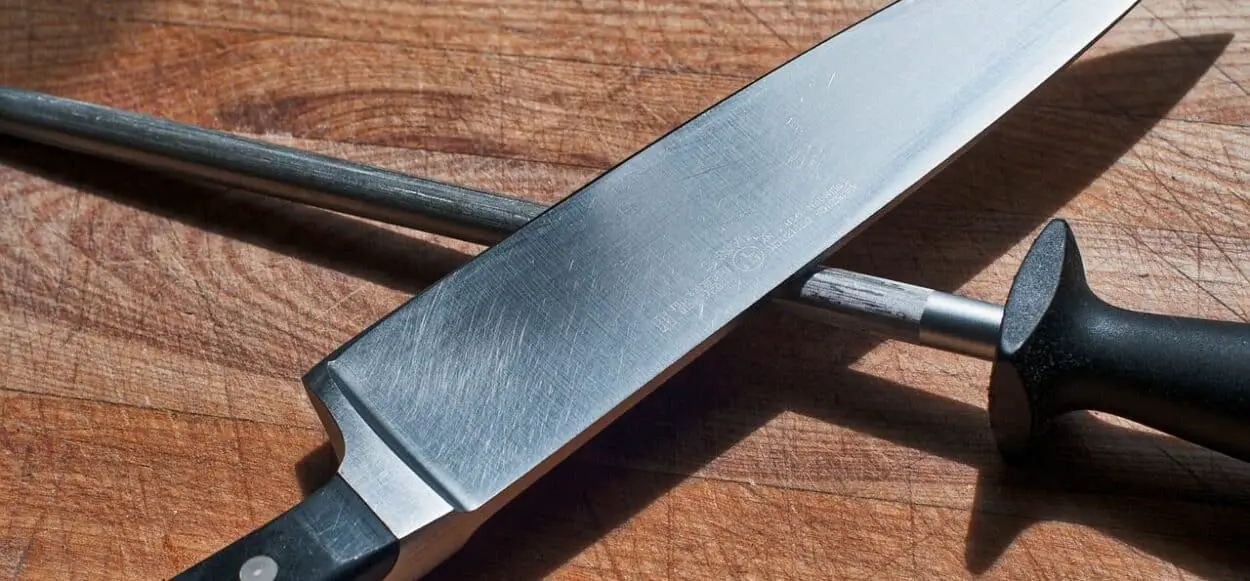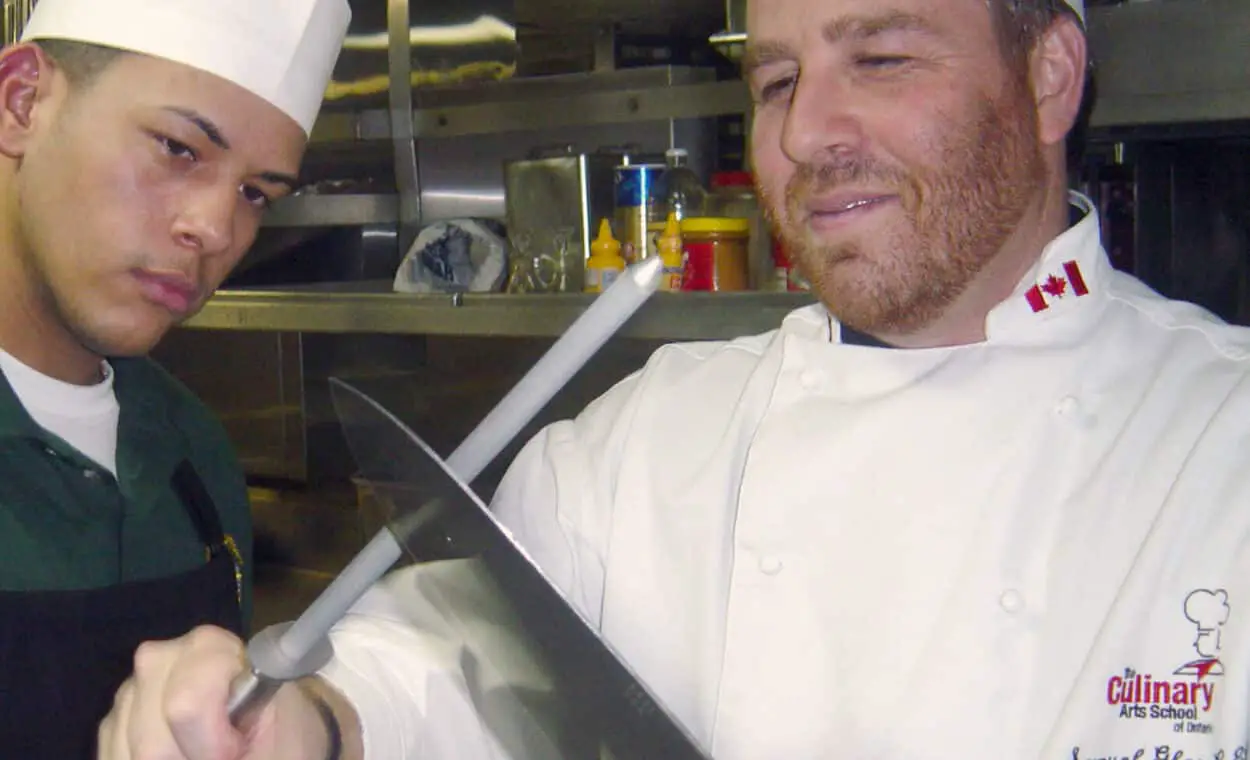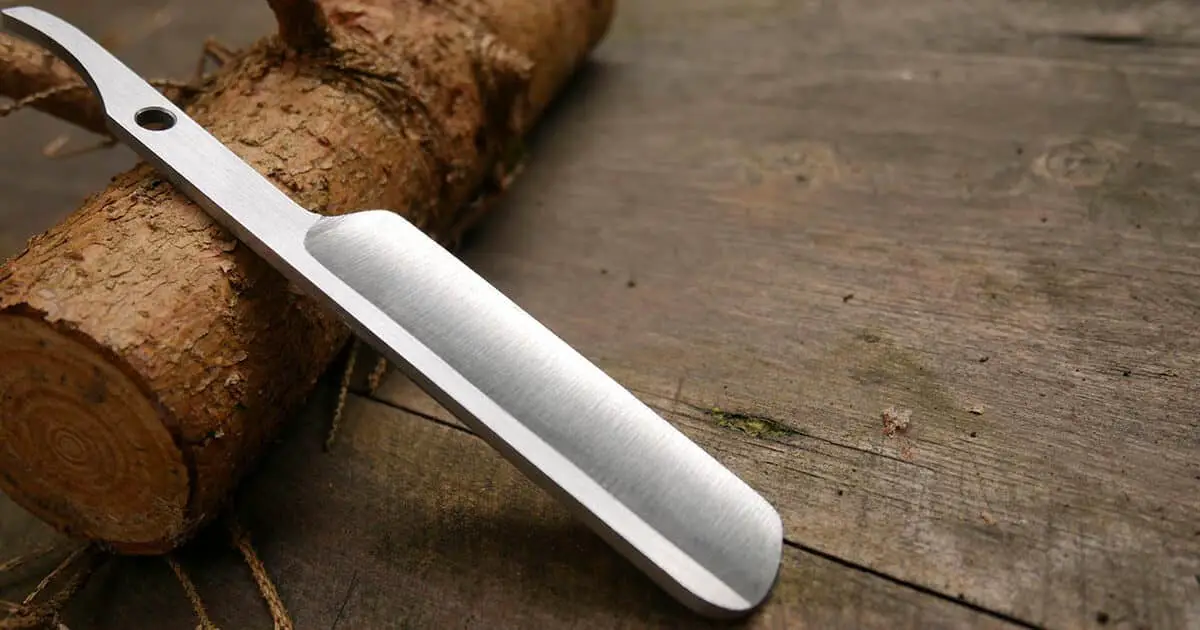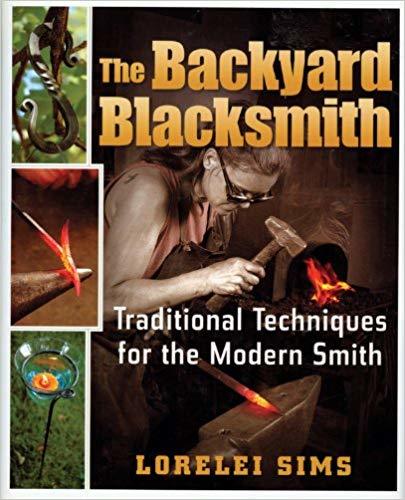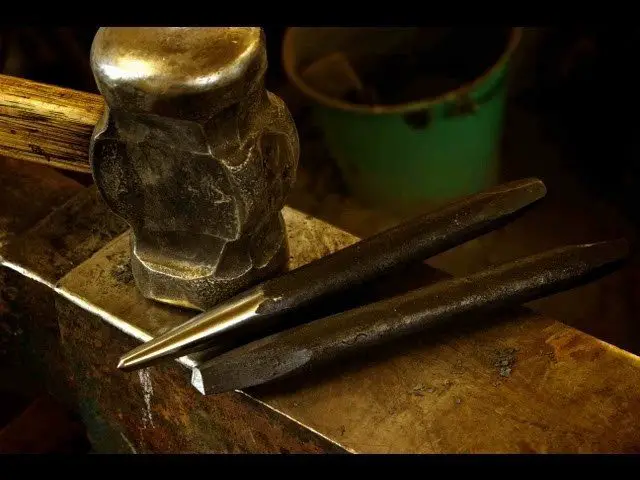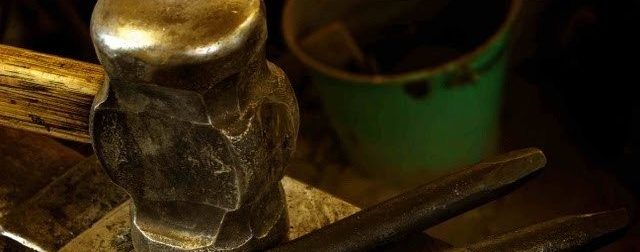One of the biggest advantages of forging your own knife is the personality you can infuse in it. Sure, you could buy a knife that’ll be just about as good as a hand-forged knife, but it won’t have any character. It’ll also probably cost a lot more than your own creation would – especially if you use scrap metals to forge.
So what is the best scrap metal to use for knife making? And are knives scrap metal? The short answer is.. No, knives are not generally made of just any scrap metal. For a knife to work it needs to be both hard, to hold a keen edge, and flexible so it doesn’t snap in two. While you can shape almost any material into knife shape, a blade made of cast iron (for example) won’t hold an edge for more than a cut or 2.
- Quantity: 3 Blanks
Prices pulled from the Amazon Product Advertising API on:
Product prices and availability are accurate as of the date/time indicated and are subject to change. Any price and availability information displayed on [relevant Amazon Site(s), as applicable] at the time of purchase will apply to the purchase of this product.
The good thing about metals (and steel in particular) is that despite whatever form they previously took once they are heated, they can be reshaped, given an edge and more. Smaller but thick steel can be pounded down to a wider, flatter knife shape with enough work. This means that a surprising number of “scrap” metals can be used for knife forging – and bring their stories along with them.
What Is A Good Knife Making Steel?
The ideal type of metal for your knife or blade depends on what you plan to use it for. For hatchets, machetes, and other blades that have to withstand impacts, you want a tougher and stronger metal that won’t fracture. For finer knives that emphasize cutting, you’ll want something strong and hard, but it won’t face much impact, so it doesn’t need to be as tough.
When it comes to determining the strength, hardness, and toughness of your knife, the carbon content plays a major role. In steels with higher carbon content, the metal is going to be harder and stronger because it helps hold the iron atoms in place. However, if there is too much carbon it becomes brittle and you risk fracturing with any impact.
Overall, the ideal knife will have the right percentage of carbon and other alloys to perform what it was made to do effectively without risking breaking or other damage.
What to Look for in Potential Scrap
When looking through your local junkyard or workshop for scrap, you’ll want to keep an eye out for anything that was regularly put under strain. This is because the steel used in these scrap items would need a higher percentage of carbon to be able to withstand pushing and pulling, but a low enough carbon content so that it is not brittle enough to fracture outright. In many cases, this carbon content is great for all-purpose knives and shouldn’t give you too much trouble when it comes to forging.
Additionally, you’ll need to consider the size of the scrap you’re going to use. If you plan to make a 6-inch blade, you need something of a similar size because although you can hammer the steel to various shapes, you cannot suddenly make more appear to fit your project. Fortunately, you can always cut a piece off of a bigger piece to make a smaller knife, which is why many scrap knives are smaller.
You can also perform some basic tests on the scrap you come across, such as scratching the material to determine the hardness, trying to bend it to test strength, or smacking it into something to test toughness. If there is a fracture or other serious damage sustained, it probably won’t last through the forging process.
2 Ways to Test Scrap Metals
-
Harden then break a small piece
Take a small piece and heat it till it is no longer magnetic (that’s a very general way to know you got it hot enough) then quench it in oil to harden it. many common metals used in knife making are oil quenchable so it’s a good place to start.
Take your quenched and cooled piece and put in a vice then smack the side of the piece hard with your hammer. If it is hardenable steel it will break rather than bend. If it bends either it’s low carbon steel or it’s a water quenching steel. Try the same heat then quench process but use water this time. If the piece still bends it’s no good for knives since it won’t hold an edge.
-
Spark Test
By taking a piece of your mystery metal and touching it to your grinding wheel you can judge the carbon content by the color and shape of the sparks. It is FAR easier to understand with a video than in words so give this quick (just over 1 minute) video a watch.
Pretty straight forward, right?
The Best Scrap Metal to Use for Knife Making
Below are some of the more viable scrap pieces to consider for your home forging. Depending on your plans for the blade, some may work better than others but if you’re able to get one, it’s hard to go wrong. Just aim for older pieces of steel as they don’t make things like they used to, with older steel being higher quality overall.
Suspension Springs
At first glance, a spring may not seem like it could possibly be a knife because it is round and coiled. However, a coil is just metal wrapped around something so if you unwrap it, it becomes just a cylindrical piece of steel that can be worked like anything else. Whether you plan on breaking a piece off or unravelling the whole thing, all it takes is some extreme heat and elbow grease to have the beginnings of your new knife.
Leaf Springs
Leaf springs off an old truck are generally excellent steel for blade making. You will need to anneal them, like most found steel, but they have to bonus of being in nice flat wide bars already so its less work on the anvil to get them into a knife-like shape.
Steel Cable
If you happen to be lucky enough to find elevator cable, you could be in for a unique knife-forging experience. Like the coiled spring, steel cable is braided steel just asking to be separated and reused for one or more knives. The tension the cable is built to stand up to means it has a higher carbon percentage, so it is strong and great for knife forging.
Circular Saw Blade
Saw blades are sharp, but they can be sharper! While you won’t use the entire saw blade for a single knife, cutting a small section out from the blade would allow you to forge a decently sized knife made of very hard and edge-holding steel – as long as you find an older blade. Newer blades may not have the same chemical makeup with less strength, making them sharper but struggling to hold their shape.
Railroad Spikes
Railroad spikes are already scary as is, but when you sharpen the spike at the bottom into a blade, you’re talking about a unique knife that looks as dangerous as it is. Railroad spikes are made of stronger, more carbon-rich steel which makes them more suited towards hardness, durability, and strength than sharpness because they needed to resist the impacts of hammering when laid on tracks. Meaning they won’t have great edge retention compared to some other steels.
A railroad spike is also usually the perfect size to fit in your hand, and the large tang you can leave allows for more custom metalwork, engraving, and other unique additions to make it stand out.
Steel Files
Perhaps the most popular first knife scrap metal, the old school steel file is a great way to make a small but incredibly sharp blade that fits in your hand. These files are made to be very hard – which isn’t ideal for knife making – but can be annealed to soften the steel so that it can be better shaped before you reharden it. After shaping and annealing, you’ll have a versatile piece of steel that will be hard, hold an edge well, and make a great knife.
Sourcing Scrap Metal for Knife Making Steel
Finding suitable scrap metal for your DIY knife making hobby or business venture is certainly easier now than it was a decade ago. This is due to an increased number of viable sources of affordable raw materials for knife making steel. You can easily find scrap metal items that have knife making steel by checking out the following places.
-
Immediate Neighborhood
Your neighbors should be more than happy to let you have any scrap metal items that might be lying around on their property such as old refrigerators, lawnmowers, dishwashers and so forth.
-
Local Businesses
Appliance and auto repair shops in your locality should have scrap metal items that they no longer need such as old cars, washing machines, microwave ovens, deep fryers, freezers, ovens, etc.
You can also seek out steel-bearing scrap from local manufacturing facilities, warehouses, supermarkets, hotels, public schools, nearby farms and so forth.
-
Local Junkyard
A visit to your local junkyard should offer you a wide range of scrap steel items, such as vehicle parts, domestic appliances, children toys, lawnmowers, electric irons, and myriad other junk. Note that you may have to pay with a minimal fee to remove a viable scrap item from the yard. This is likely the easiest place to find the best scrap metal for knife making steel.
-
Construction and Renovation sites
You can find steel-bearing construction waste, such as steel bars and fixtures, by visiting locations where construction or renovation is underway.
-
Medical Facilities
You can also check out nearby healthcare facilities for unused items containing knife making steel such as old beds, wheelchairs, wheeled trays, damaged equipment, and so forth. It is important to ensure any such items are adequately disinfected before you take them with you.
-
Dumpsters and Dump Sites
If none of the other sources prove feasible, you can decide to check out neighborhood dumpsters and the nearby dumpsite for scrap metal items bearing knife making steel.
-
Sourcing Knife Making Steel Online
Alternatively, you can save yourself the time and effort needed to physically look for scrap metal by shopping for knife making steel online. You find a wide array of cheap second-hand items that you can use as scrap metal on craigslist.com, including old washing machines, lawnmowers, service carts, washing machines, and so forth.
Buying annealed steel billets on Amazon is advisable if you intend to pursue DIY knife making as a long-term business venture rather than as a one-time hobby.
Other Options
If I was starting out again and wanted to try my hand at a few knives I would save myself the trouble of finding metal then testing and shaping it into what might not end up being useful as a blade. This option wasn’t around when I started or I would have gone this route.
IMO the best scrap metal for knife making steel is not scrap metal at all. You can order 1095 high carbon steel billets from amazon for amazingly cheap. The fact that if you have prime you can get that heavy steel shipped for free is just icing on the cake since that is what usually kills you when ordering steel online.
Heres an example off amazon:
- Quantity: 1 Blank
- 3/16 1095 Carbon Steel
- 2 x 12 x .188
- Made in the USA
Prices pulled from the Amazon Product Advertising API on:
Product prices and availability are accurate as of the date/time indicated and are subject to change. Any price and availability information displayed on [relevant Amazon Site(s), as applicable] at the time of purchase will apply to the purchase of this product.
You can get different widths (3 Inch x 12 Inch x 0.187 Inch) and thickness (0.125 Inch) or 3-packs with several billets (1.5 Inch x 12 Inch x 0.187 Inch, 3 Pack)
If you aren’t familiar with 1095 steel it is a favorite of knife makers and reasonably easy to work on an anvil making. It’s also not super hard to cut on a bandsaw making it a great choice when starting out. Here is a very brief rundown of how to heat and use 1095 high carbon steel.
Forging: heat to 2100°F (1150°C) . Do not forge below 1500°F (815°C).
Normalizing: Heat to 1575°F (855°C). Air cool.
Annealing: Heat to 1475°F (800°C). Furnace cool to 1200°F (650°C) at a rate not exceeding 50°F (28°C) per hour. Alternately bury it in sand or even the ground to cool for several hours. I often will toss it in a campfire and dig it out in the morning.
Hardening: Austenitize- Heat to 1475°F (800°C). Thicker sections can be quenched in water or brine with extreme care but can also be oil quenched in sections under 1/4 in. (6.35 mm) thick as the preferred method.
Tempering: The quenched hardness should be approximately 66 HRC. Hardness can be adjusted downward by proper tempering.
[table id=2 /]Knife Making as a Viable Business Idea
Transforming your knife making hobby into a full-time business requires a reliable source low-cost knife making steel and a knife manufacturing process that produces consistent quality products. There are several types of professional knives you can make at home including:
-
Chef’s knife
A chef’s knife is typically an 8 to 10inch steel blade primarily used in food preparation tasks such as chopping up carrots, dicing onions, slicing cabbage, and so forth.
-
Paring Knife
A paring knife is a smaller version of the chef’s knife featuring a 5 to 7-inch blade. This stainless steel knife is also used during food preparation.
-
Boning Knife
As its name suggests, a boning knife is used in removing meat from bone and consists of a long, thin and strong stainless steel blade.
-
Bread Knife
A bread knife is typically a 4 to 6inch blade whose serrated edge allows the easy cutting of fresh bread without causing it to lose its shape.
-
Cheese Knife
As suggested by the name, the purpose of a cheese knife is to cut through the cheese. The steel blade of this knife has holes which prevent cheese from sticking to the blade by reducing surface contact.
-
Meat Cleavers
A meat cleaver is a large, heavy steel knife whose size and weight aids in cutting through meat with bones in it.
Besides professional knives, you can also delve into custom knife making which involves the production of specialty knives, with examples including flick knives, folding knives and hunting knives.
Note that specialty knife making necessitates that you have considerable knife making skills than those required with professional knives. The reason being, specialty knives often feature complex blade retrieval/concealment mechanisms.
Selling your Knives
You can begin marketing your professional and specialty knives to neighbors and friends. The initial feedback you get can help you to refine further your knife product offering, such as increasing/reducing blade length, adjusting the blade thickness and enhancing the grip of the knife’s handle.
Armed with a refined product, you can then start approaching local hotels, restaurants, supermarkets, butcher shops, hunting stores, and other businesses with an interest in professional and specialty knives.
In addition to direct marketing, you can also sell your professional and specialty knife products online. A most cost-effective method of attaining this objective is using a free drag-and-drop website builder like Wix.com. Using appealing website templates, you can realize an online knife store that grants access to an incredibly vast pool of potential customers on the web. Your online marketing approach can even encompass advertising your professional and specialty knife products on social media platforms like Facebook, Instagram, Reddit, and myriad others.
DIY Knife Making Process
Making a knife from scratch requires that you obtain a thick flat steel plate from the scrap metal you have sourced. You must also possess a few essential metalworking tools, which include:
- A Marker Pen: for drawing the outline of the blade on paper and marking the blade’s center
- A Hacksaw and multiple High Tensile Blades: for cutting the steel plate to appropriate size
- A Bench Vice: to firmly grip the steel plate as you work on it
- Bastard Mill and Chainsaw Files: for rounding out sharp edges, achieving the blade profile and sharpening its edge
- An Etching Tool: for marking down the outline of the blade onto the steel plate
- An Electric Drill; for making holes to aid the cutting of the thick steel plate
- A Belt or Random Orbit Sander: for polishing the finished blade
- An Electric Grinder: for obtaining a rough blade outline and tapering down the flat steel plate when creating the knife-edge
The Basic Knife Making Steps
- You begin making your knife by etching the outline of the blade onto your steel plate using the etching tool. You draw the desired shape of the knife on paper using the maker, cut out the shape, and then use the cut-out to etch the blade design onto the steel plate.
- You then use the electric drill to punch holes through the steel plate along the outer edge of the blade outline. These holes make it easier for you to cut through the thick steel plate.
- Next, use the bench vice to firmly grip the steel plate as you commence cutting out the blade from the larger steel plate with the hacksaw. Adjust the point of the grip of the vice as while cutting out different parts of your blade outline.
Alternatively, you can use a metal cutting band saw to cut out the blade outline on the steel plate. Regardless of You are left with a rough blade once you complete cutting it out from the steel plate.
- After that, remove the steel plate from the vice and replace it with the rough blade and use the grinder to smooth out the hole marks on the edges. Ensure you have a container with cold water nearby to cool down the hot blade once you are done smoothing out the blade with the grinder.
- Once the blade has cooled down, wipe off the water and then use the electric drill to make holes, 1inch apart, on the handle-end of the blade. These holes help you to firmly fix the blade into the workbench as you file it down to achieve a knife profile.
- Begin by Identifying the center of the blade and mark it with the marker. Then firmly fix the blade towards the edge of your workbench via the holes on its handle. With the bastard mill file held flat onto the blade and starting at its center, begin filing down the blade towards the intended edge to achieve a knife profile.
Gradually wear down the blade to half its thickness before unscrewing it from the bench. Turn the blade over and refix it to the workbench using the screws. Repeat the process of filing down the blade towards the intended edge.
- Once you have achieved the knife profile on the blade, start using the chainsaw file to smooth out scratches made on the blade by the bastard mill file. Ensure you do this for both sides of the blade for a fine finish of the blade’s edge.
- Now that your knife blade is almost done, you must heat-treat it to enhance its service life. Heat treating your blade aids to reduce its brittleness and increase its hardness. You can heat-treat the blade in one of two ways.
- Place the knife in a blazing hot forge for a few minutes and then let it cool down slowly. Repeat this process two or three times. Note that this is the standard heat-treatment procedure used by professional blacksmiths.
- Alternative, light a wood fire and let the fire burn down to embers. Then place the embers in the red hot embers for until it gets red hot, before removing it and allowing it to cool down slowly. Repeat this process two or three times.
- At this point, you are almost through with your first DIY knife. Heat-treatment causes the knife to blacken. You, therefore, have to polish the knife using the belt or random orbit sander to remove the black tinge on the blade caused by the fire.
- The final step of your DIY knife making revolves around fixing a handle to the blade. You can choose to install a rubber or wooden handle to the blade of your DIY knife. You begin by cutting appropriately sized pieces of wood or rubber for either side of the blade. You then modify each piece to your desired shape and design.
Next, you make holes on the handle pieces that correspond to the holes on the handle-end of the blade. Finally, you set the two rubber/wood pieces to either side of the finished blade and fix them using bolts and nuts or glue. You have now completed making your DIY knife.
This is obviously a very high level guide to what is a long and intricate process. Here is a video that shows most of the process.
Final Thoughts
In the end, making a knife from scrap metal is a cost-effective way to forge for fun. Not knowing the specific chemical composition of the metals you use adds a bit of guesswork to certain things like the ideal temperature and treatment method, but as long as you don’t mind it being a bit rough around the edges, scrap metal can be used to make a perfectly good knife.
You’ll want to look for high-carbon steel scrap that is built to be hard but not brittle like springs or cables for the most versatile option, or stronger pieces like railroad spikes if you’re going for something with a little more impact.
Overall, if you’re making the knife for yourself it’s hard to go wrong with any of the scrap recommendations. Some will work better than others for what you’re trying to do, but as long as you enjoy the process, that’s the fun of knife forging.
